- Clone
- mAb 33 (33) (See other available formats)
- Regulatory Status
- RUO
- Other Names
- KIR2DL4, 2DL4, p49, KIR103
- Isotype
- Mouse IgG1, κ
- Ave. Rating
- Submit a Review
- Product Citations
- publications
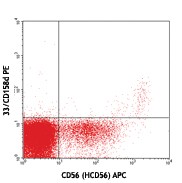
-

Human peripheral blood lymphocytes were cultured 16 hrs with IL-2, then stained with CD56 (clone HCD56) APC and CD158d (clone 33) PE (top) or mouse IgG1, κ PE isotype control (bottom). -

| Cat # | Size | Price | Quantity Check Availability | Save | ||
|---|---|---|---|---|---|---|
| 347009 | 100 µg | 216€ | ||||
| 347010 | 1 mg | 595€ | ||||
CD158 molecules, also known as KIRs (killer cell immunoglobulin-like receptors), are a family of transmembrane proteins with either two (KIR2D) or three (KIR3D) Ig-like extracellular domains. Some KIRs, with long cytoplasmic domains, contain ITIMs and possess inhibitory functions and others, with short cytoplasmic regions, lack ITIM and have activation functions. Fourteen polymorphic KIR genes have been reported in humans. KIR2DL4 (CD158d) is a unique receptor which has an ITIM in its cytoplasmic domain and a charged residue in the transmembrane domain. It possesses both inhibitory and activation functions. Two common alleles (10A and 9A) of KIR2DL4 have been reported. The 10A allele (with 10 adenines at the end of the transmembrane exon) receptor is expressed on CD56high NK subset, whereas its expression on CD56dim NK cells is inducible upon culture. The major 9A allele receptor is a secreted form. HLA-G is the ligand of CD158d.
Product DetailsProduct Details
- Verified Reactivity
- Human
- Antibody Type
- Monoclonal
- Host Species
- Mouse
- Immunogen
- NK3.3 cells and KIR2DL4-Ig fusion protein
- Formulation
- 0.2 µm filtered in phosphate-buffered solution, pH 7.2, containing no preservative.
- Endotoxin Level
- Less than 0.01 EU/µg of the protein (< 0.001 ng/µg of the protein) as determined by the LAL test.
- Preparation
- The Ultra-LEAF™ (Low Endotoxin, Azide-Free) antibody was purified by affinity chromatography.
- Concentration
- The antibody is bottled at the concentration indicated on the vial, typically between 2 mg/mL and 3 mg/mL. Older lots may have also been bottled at 1 mg/mL. To obtain lot-specific concentration and expiration, please enter the lot number in our Certificate of Analysis online tool.
- Storage & Handling
- The antibody solution should be stored undiluted between 2°C and 8°C. This Ultra-LEAF™ solution contains no preservative; handle under aseptic conditions.
- Application
-
FC - Quality tested
Activ - Reported in literature, not verified in house - Recommended Usage
-
Each lot of this antibody is quality control tested by immunofluorescent staining with flow cytometric analysis. For flow cytometric staining, the suggested use of this reagent is ≤ 1.0 µg per 106 cells in 100 µl volume or 100 µl of whole blood. It is recommended that the reagent be titrated for optimal performance for each application.
- Application Notes
-
KIR2DL4 expression in NK cells is highly localized to the endosomes3. mAb 33 can be internalized by NK cells by endocytosis at 37°C3, and induces NK cell cytotoxicity1,2. Based on in-house observations, we suggest incubating for 45 - 60 minutes at room temperature with clone mAb 33 to observe better CD158d staining.
This clone has been tested in-house and determined to not be suitable for applications in immunohistochemistry of paraffin-embedded tissue sections (IHC-P). -
Application References
(PubMed link indicates BioLegend citation) -
- Rajagopalan S, et al. 2001. J. Immunol. 167:1877. (FC)
- Goodridge JP, et al. 2003. J. Immunol. 171:1768. (FC)
- Rajagopalan S, et al. 2006. PLoS Biol. 4:e9.
- RRID
-
AB_2894481 (BioLegend Cat. No. 347009)
AB_2894481 (BioLegend Cat. No. 347010)
Antigen Details
- Structure
- Contains two Ig-like extracellular domains, 45-50 kD
- Distribution
-
On CD56high NK cells and cultured CD56dim NK cells
- Ligand/Receptor
- HLA-G
- Cell Type
- NK cells
- Biology Area
- Immunology, Innate Immunity
- Molecular Family
- CD Molecules
- Antigen References
-
1. Rajagopalan S, et al. 2006. PLoS Biol. 4:e9.
2. Goodridge JP, et al. 2007. Eur. J. Immunol. 37:199. - Gene ID
- 3805 View all products for this Gene ID
- UniProt
- View information about CD158d on UniProt.org
Related Pages & Pathways
Pages
Related FAQs
- Do you guarantee that your antibodies are totally pathogen free?
-
BioLegend does not test for pathogens in-house aside from the GoInVivo™ product line. However, upon request, this can be tested on a custom basis with an outside, independent laboratory.
- Does BioLegend test each Ultra-LEAF™ antibody by functional assay?
-
No, BioLegend does not test Ultra-LEAF™ antibodies by functional assays unless otherwise indicated. Due to the possible complexities and variations of uses of biofunctional antibodies in different assays and because of the large product portfolio, BioLegend does not currently perform functional assays as a routine QC for the antibodies. However, we do provide references in which the antibodies were used for functional assays and we do perform QC to verify the specificity and quality of the antibody based on our strict specification criteria.
- Does BioLegend test each Ultra-LEAF™ antibody for potential pathogens?
-
No, BioLegend does not test for pathogens in-house unless otherwise indicated. However, we can recommend an outside vendor to perform this testing as needed.
- Have you tested this Ultra-LEAF™ antibody for in vivo or in vitro applications?
-
We don't test our antibodies for in vivo or in vitro applications unless otherwise indicated. Depending on the product, the TDS may describe literature supporting usage of a particular product for bioassay. It may be best to further consult the literature to find clone specific information.
Other Formats
View All CD158d Reagents Request Custom Conjugation| Description | Clone | Applications |
|---|---|---|
| PE anti-human CD158d (KIR2DL4) | mAb 33 (33) | FC |
| APC anti-human CD158d (KIR2DL4) | mAb 33 (33) | FC |
| TotalSeq™-A0913 anti-human CD158d (KIR2DL4) | mAb 33 (33) | PG |
| Ultra-LEAF™ Purified anti-human CD158d (KIR2DL4) | mAb 33 (33) | FC,Activ |
| TotalSeq™-B0913 anti-human CD158d (KIR2DL4) | mAb 33 (33) | PG |
Compare Data Across All Formats
This data display is provided for general comparisons between formats.
Your actual data may vary due to variations in samples, target cells, instruments and their settings, staining conditions, and other factors.
If you need assistance with selecting the best format contact our expert technical support team.
-
PE anti-human CD158d (KIR2DL4)
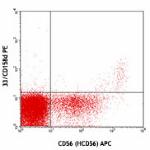
Human peripheral blood lymphocytes were cultured 16 hrs with... 
-
APC anti-human CD158d (KIR2DL4)

IL-2 stimulated (18hrs) human peripheral blood lymphocytes s... 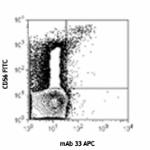
IL-2 stimulated (18hrs) human peripheral blood lymphocytes s... -
TotalSeq™-A0913 anti-human CD158d (KIR2DL4)
-
Ultra-LEAF™ Purified anti-human CD158d (KIR2DL4)
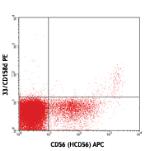
Human peripheral blood lymphocytes were cultured 16 hrs with... 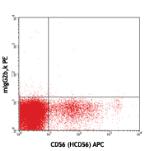
-
TotalSeq™-B0913 anti-human CD158d (KIR2DL4)
 Login / Register
Login / Register 









Follow Us